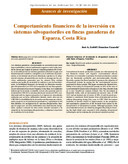| dc.contributor.author | Gobbi, José A. | es_ES |
| dc.contributor.author | Casasola Coto, Francisco | es_ES |
| dc.date.accessioned | 2015-03-19T21:07:56Z | |
| dc.date.available | 2015-03-19T21:07:56Z | |
| dc.date.issued | 2003 | |
| dc.identifier | 470528 | es_ES |
| dc.identifier.issn | 1022-7482 | es_ES |
| dc.identifier.uri | https://repositorio.catie.ac.cr/handle/11554/5923 | |
| dc.description | 3 ilus. 6 tab. 16 ref. 9 pág. | es_ES |
| dc.description.abstract | Este trabajo examina, por medio de un modelo de análisis ex-ante de beneficio-costo, la factibilidad financiera de invertir en diferentes tecnologías silvopastoriles en el 20% de la superficie de una finca ganadera convencional en la zona de Esparza, Costa Rica. Los resultados indican que la inversión es rentable, con un valor presente neto incremental de US 1613 y una tasa interna de retorno del 20%, considerando solo los ingresos pecuarios. Los ingresos no descontados estimados por servicios ambientales durante cuatro años son de US 3369. La factibilidad de la inversión está directamente relacionada a mejoras en los parámetros productivos y reproductivos del hato debidas a la incorporación de sistemas silvopastoriles. Aunque los pagos por servicios ambientales son relativamente marginales, ayudan a atenuar los altos costos iniciales asociados a la adopción de las tecnologías silvopastoriles y a disminuir el período de reembolso de la inversión. This paper examines the financial feasibility of investing in silvopastoral systems on 20% of the area of a conventional livestock farm in Esparza, Costa Rica. Results from an ex-ante benefit-cost analysis indicate that the investment is financially viable, with an incremental net present value of US 1,613 and an internal rate of return of 20%, if only livestock production is considered. Total income from environmental services without discounting during four years is US 3,369. Investment feasibility is directly related to improvements in the productive and reproductive parameters of the livestock herd caused by the incorporation of silvopastoral systems. Although payments from environmental services are relatively marginal, they help in lessening the high initial costs associated with adopting silvopastoral technologies and in reducing the investment’s payback period. | es_ES |
| dc.format.mimetype | pdf | |
| dc.language.iso | es | es_ES |
| dc.publisher | CATIE, Turrialba (Costa Rica) | es_ES |
| dc.relation.ispartof | Agroforestería en las Américas, número 39-40 (2003) | |
| dc.rights.uri | https://creativecommons.org/licenses/by-nc-nd/4.0/ | |
| dc.subject | ANALISIS DE COSTOS Y BENEFICIOS | es_ES |
| dc.subject | INVERSIONES | es_ES |
| dc.subject | RENTABILIDAD | es_ES |
| dc.subject | ESTUDIOS DE FACTIBILIDAD | es_ES |
| dc.subject | SISTEMAS SILVOPASCICOLAS | es_ES |
| dc.subject | EXPLOTACIONES AGRARIAS | es_ES |
| dc.subject | GANADO BOVINO | es_ES |
| dc.subject | PRODUCCION ANIMAL | es_ES |
| dc.title | Comportamiento financiero de la inversión en sistemas silvopastoriles en fincas ganaderas de Esparza, Costa Rica | es_ES |
| dc.title.alternative | Financial behavoir of investments in silvopastoral systems in cattle farms of Esparza, Costa Rica | es_ES |
| dc.type | Artículo | es_ES |
| dc.journal.volume | 10 | |
| dc.journal.issueNumber | 39-40 | |
| dc.journal.pages | 52-60 | |



